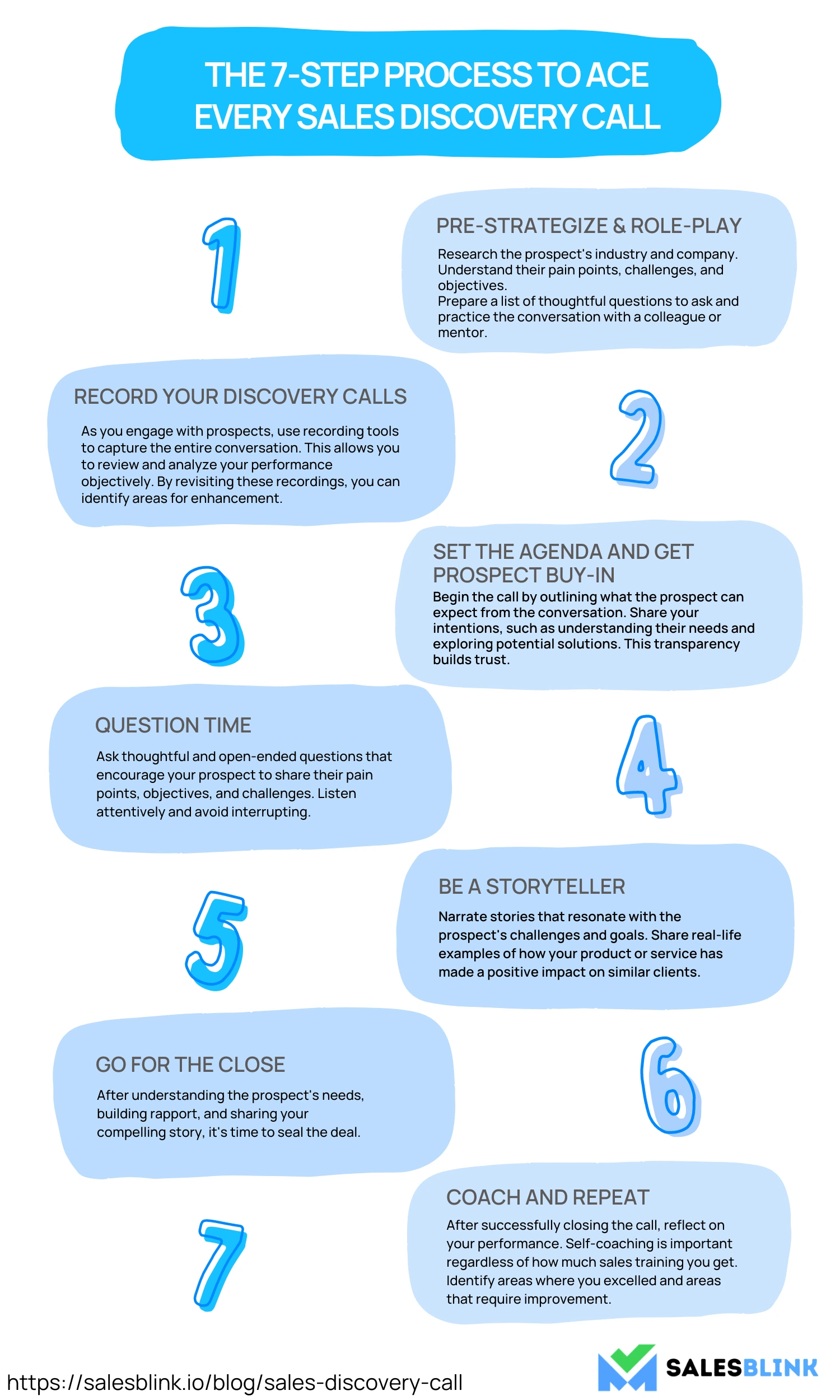The 7-Step Process To Ace Every Sales Discovery Call
Do you want to ace every sales discovery call but don’t know how to? You may miss out on many opportunities if you choose to stay in the dark. Here’s your chance to maximize your chances of engaging the prospect and guiding them toward a mutually beneficial outcome.
In this blog post, we’ll show you the benefits of discovery calls and unveil a comprehensive 7-step sales process that empowers you to confidently lead critical conversations.
Get ready to add it to your sales strategy.
So, without much ado, let’s begin!
Table of Contents
What is a Discovery Call in Sales?
A discovery call in sales is an initial conversation between a salesperson or sales team and a potential customer or prospect. The primary purpose of a discovery call is to gather information, build rapport, and assess whether the product or service being offered aligns with the prospect’s needs and goals.
During this call, you can ask questions to understand the prospect’s pain points, goals, and current situation. Lead qualification is a key objective, determining whether the prospect is genuinely interested, has decision-making authority, and has the budget for the offering.
The aim is to identify how the product or service can address the prospect’s needs and set clear expectations for the next steps in the sales process. The discovery call also helps uncover objections or concerns you can address in future interactions. It’s a critical step in sales that saves time by focusing efforts on leads with higher conversion potential while building a foundation for a productive business relationship.
What Are The Benefits Of Discovery Calls?
Here are the benefits of handling sales discovery calls the right way,

1. Helps Empathize with Prospects
Discovery calls provide you with an opportunity to truly understand the potential customers’ pain points, challenges, and goals. This deeper understanding allows you to empathize with the prospects’ situation. By listening attentively and asking probing questions, you can put yourself in the prospects’ shoes, demonstrating genuine interest in their needs. This empathetic approach fosters a stronger connection and trust between you and the prospect, making it more likely for the prospect to engage further in the sales process.
2. Offers Relevant Solutions
Through effective discovery calls, you, as a sales rep, can gather valuable insights into the prospect’s specific needs and requirements. With this knowledge, you can tailor their product or service offerings to provide solutions that directly address the prospect’s pain points. This personalized approach increases the likelihood of meeting the prospect’s expectations and enhances the value of the offering. It demonstrates that you are not just pushing a generic product but are genuinely interested in helping the prospect solve their unique problems.
3. Builds the Buyer’s Journey
You can tailor their interactions by identifying where the prospect stands in their decision-making process. For instance, if the prospect is in the early stages of research, you can provide educational resources. In contrast, a prospect closer to deciding may require more detailed information and pricing options. This tailored approach guides prospects smoothly through their journey, increasing the likelihood of conversion.
4. Establishes the Authenticity of the Sales Reps
Authenticity is crucial in sales. A genuine, human connection built during a discovery call helps establish the authenticity of the sales representative. When prospects feel that you are sincere, honest, and truly interested in helping them, it builds trust. Authenticity is a key factor in influencing buying decisions, as prospects are likely to engage with individuals they believe have their best interests at heart.
5. Personalizes Experiences for Prospects
Each prospect is unique, and their needs may differ significantly. Discovery calls enable you to gather information for a highly personalized sales plan. This personalization extends beyond product recommendations to the entire sales process, including communication preferences, follow-up methods, and engagement timing. Tailoring the experience to align with the prospect’s preferences enhances their overall satisfaction and engagement, increasing the chances of a successful sale.
How Long Should A Sales Discovery Call Be?

The ideal duration of a sales discovery call typically falls between 15 to 60 minutes. This timeframe allows enough time to thoroughly understand the prospect’s needs, challenges, and goals while ensuring the conversation remains focused and engaging.
Going beyond 60 minutes may risk losing the prospect’s attention or making the call feel too lengthy. However, this duration may vary based on factors like the complexity of the sale, the prospect’s availability, and the depth of information required. It’s essential for sales professionals to strike a balance between gathering the necessary information and respecting the prospect’s time, aiming for a concise, productive conversation that leaves room for further engagement in the sales process.
The 7-Step Sales Discovery Call Structure
Here’s the structure of a sales discovery call,

1. Pre-strategize & role-play
As a salesperson, the first crucial step in the Sales Discovery Call Structure is pre-strategizing and engaging in role-play. This phase sets the foundation for a successful conversation with your prospect.
Start by thoroughly researching the prospect’s industry and company. Understand their pain points, challenges, and objectives. Also, check your ideal customer profile once. This knowledge will help tailor your approach and questions effectively.
Next, establish clear objectives for the call.
What information do you need to gather?
What are your desired outcomes?
Having a well-defined purpose keeps you on track during the conversation.
Prepare a list of questions to ask. These questions should extract valuable information and demonstrate your genuine interest in solving the prospect’s problems.
Role-playing is your secret weapon. Practice the conversation with a colleague or mentor. This helps refine your pitch, anticipate objections, and enhance your confidence.
2. Record your discovery calls
The second step in the Sales Discovery Call Structure is to record your discovery calls. This practice provides invaluable insights and a learning opportunity for continuous improvement.
As you engage with prospects, use recording tools to capture the entire conversation. This allows you to review and analyze your performance objectively. Pay attention to your tone, pacing, and the effectiveness of your questions.
By revisiting these recordings, you can identify areas for enhancement, refine your communication skills, and fine-tune your pitch. It’s a proactive way to learn from both successful and less successful calls, ultimately helping you become a more effective salesperson. Recording your discovery calls ensures that each interaction contributes to your growth and success in the long run.
3. Set the agenda and get prospect buy-in
The third vital step in the Sales Discovery Call Structure is to set the agenda and secure the prospect’s buy-in. It’s your opportunity to establish clarity and align expectations.
Begin the call by outlining what the prospect can expect from the conversation. Share your intentions, such as understanding their needs and exploring potential solutions. This transparency builds trust and demonstrates professionalism.
Invite the prospect’s active participation and agreement with the agenda. Ask if they have any specific topics they’d like to cover. This ensures the call addresses their priorities and fosters a collaborative atmosphere.
By setting the agenda and gaining the prospect’s buy-in, you create a structured discussion that benefits both the prospect and you, increases engagement, and moves the sales process forward more smoothly. It’s a crucial step in building a productive relationship with your prospect.
4. Question time
The fourth step in the Sales Discovery Call Structure is “Question Time.” This is when you, as the salesperson, engage in active questioning to uncover valuable information.
Ask thoughtful, open-ended questions, encouraging your prospect to share their pain points, objectives, and challenges. Listen attentively and avoid interrupting. Your goal is to understand their needs.
Use probing questions to dig deeper into specific areas of interest or concern. Empathize with their responses and ask follow-up questions to clarify and gather more insights.
Remember, this phase is about the prospect, not the product. The more you learn, the better equipped you’ll be to tailor your solution effectively. Effective questioning is the key to discovering the path to a successful sale.
5. Be a storyteller
Step five in the Sales Discovery Call Structure is “Be a Storyteller.” After understanding the prospect’s needs, it’s time to weave a compelling story.
Narrate stories that resonate with the prospect’s challenges and goals. Share real-life examples of how your solution helped similar clients. Make it relatable and emotionally engaging.
Through storytelling, you showcase the value and benefits of your offering, making it tangible and memorable. Stories create a connection, making it easier for the prospect to envision the solution in their own context.
Becoming a storyteller transforms information into inspiration, strengthening your position as an advisor and increasing the chances of converting the prospect into a satisfied customer.
6. Go for the close
The sixth and critical step in the Sales Discovery Call Structure is “Go for the Close.” After understanding the prospect’s needs, building rapport, and sharing your compelling story, it’s time to seal the deal.
Transition smoothly from storytelling to presenting your solution. Recap how your product or service aligns perfectly with their challenges and goals. Address any remaining concerns or objections with confidence, using the insights gathered during the call.
Ask for the prospect’s commitment, whether it’s scheduling a demo, signing a contract, or moving to the next phase of the sales process. Be clear, concise, and positive in your request.
Going for the close is the end of your efforts, turning a potential lead into a satisfied customer. With a well-crafted approach, you solidify the value you bring to their business and pave the way for a successful partnership.
7. Coach and repeat
In the Sales Discovery Call Structure, the seventh step, “Coach and Repeat,” offers a unique opportunity for self-improvement. After successfully closing the call, reflect on your performance.
Self-coaching is important regardless of how much sales training you get. It involves analyzing your approach critically. Assess how well you understood the prospect’s needs, conveyed the solution, and addressed objections. Identify areas where you excelled and areas that require improvement.
Reiterate your commitment to providing value, not just to the prospect but to yourself as well. Set personal goals for improvement, focusing on refining your questioning, storytelling, and closing techniques. Continual self-coaching is the key to becoming a more effective and successful salesperson, ensuring your ongoing growth and success in the field.
Sales Discovery Call Script: Questions to Ask in a Call

Let’s look at the questions that play a crucial role in sales discovery questions,
What goals do you wish to achieve right now?
This question sets the stage for the entire conversation. It encourages the prospect to mention their current objectives, allowing you to tailor your approach accordingly. Understanding their goals is fundamental as it informs you about the prospect’s immediate needs and how your product or service can potentially help them achieve those objectives.
What are the roadblocks to reaching that goal?
Identifying roadblocks helps pinpoint the specific challenges the prospect is facing. This question allows you to dive deeper into their pain points, gaining insight into the obstacles that hinder their progress. With this information, you can offer targeted solutions that directly address their barriers, making your pitch more relevant and appealing.
What is at stake if your company is unable to reach this goal?
Understanding the outcome of failure is a powerful motivator. This question highlights the potential risks and losses the prospect’s company faces if they don’t achieve their goal. It adds urgency to the conversation and emphasizes the value of your product or service in minimizing those risks, creating a compelling case for your offering.
Who is involved in choosing your software?
Identifying decision-makers and stakeholders is vital for a complex B2B sale. This question helps you understand the prospect’s organizational structure and decision-making process. It ensures you engage with the right individuals, customize your messaging to their roles and priorities, and know the complexities of multi-person decision-making.
What other software has your company used?
Knowing the prospect’s history with software solutions provides valuable context. It enables you to gauge their level of familiarity with technology and your competitors. This insight informs your pitch and allows you to proactively highlight your product’s unique features or advantages, addressing potential objections.
What is your budget for achieving this goal?
Budget constraints can be a make-or-break factor in the sales process. Understanding the prospect’s budget allows you to align your product or service with their financial capabilities. It also helps you determine whether your solution is a good fit financially, preventing wasting time on leads that cannot afford your offering.
Do you have any concerns about our solution that I can address?
This question invites the prospect to express their reservations or objections directly. It demonstrates your willingness to address their specific concerns and builds trust. By addressing these concerns early in the conversation, you can clarify any misconceptions and present compelling counter-arguments, reducing barriers to closing the sale.
Can we schedule a follow-up with one of our sales reps?
Proposing a follow-up demonstrates your commitment to moving the sales process forward. It also allows you to transition from the discovery phase to the next steps. By setting a clear action plan, you can guide the prospect towards deeper engagement, whether it’s a product demonstration, a proposal presentation, or further discussions.
Master Your Next Sales Discovery Call
The 7-step process we’ve explored in this blog post provides a clear path to conducting these calls and excelling at them.
From the moment you set the agenda and engage with the prospect to the critical steps of questioning, storytelling, and closing, these guidelines have equipped you with the tools to navigate each stage confidently. You’ve learned to uncover needs, address objections, and build rapport while taking the conversation toward a sealed deal.
Remember, the discovery call is the most important part of the sales cycle and is not just a transaction—it’s an opportunity to make a lasting impression, solve real problems, and build meaningful business relationships.
So, go ahead, put this 7-step process into action. Don’t forget to thank us when you start seeing a spike in the number of closed deals.
FAQs
To prepare for a sales discovery call, research the prospect’s industry and company. Use LinkedIn and company websites for insights. Craft open-ended questions to uncover their needs, budget, and decision-making process.
A discovery call is vital in sales as it’s the first interaction with a potential customer. It helps gather key information about the prospect’s needs, challenges, & goals. This enables the sales team to qualify leads, tailor pitches, & offer targeted solutions.
A discovery call is not the same as a cold call. A cold call is an initial contact with a potential customer to introduce a product or service. A discovery call, however, follows some prior engagement and aims to gather detailed information about the prospect’s needs to tailor a solution.







